Health and Social Care: Supporting Child & Young Person Development
VerifiedAdded on 2023/06/14
|28
|7326
|436
Homework Assignment
AI Summary
This assignment provides a comprehensive overview of child and young person development within the context of health and social care. It addresses various aspects, including the different rates of development, influencing factors (personal and external), and supporting theories. The assignment emphasizes the importance of monitoring development, addressing disabilities, and promoting positive outcomes through interventions. It also covers speech, language, and communication disabilities, highlighting multiagency support and the role of play and activities. Furthermore, the assignment delves into the significance of positive relationships, self-esteem, and collaborative work for the benefit of children and young people. It explores strategies for promoting well-being, resilience, and educational potential, alongside supporting positive changes in their lives. The document also touches upon professional practice in children and young people's social care, ensuring a holistic understanding of the subject matter. Desklib provides additional resources for students.

HEALTH AND SOCIAL CARE
Paraphrase This Document
Need a fresh take? Get an instant paraphrase of this document with our AI Paraphraser
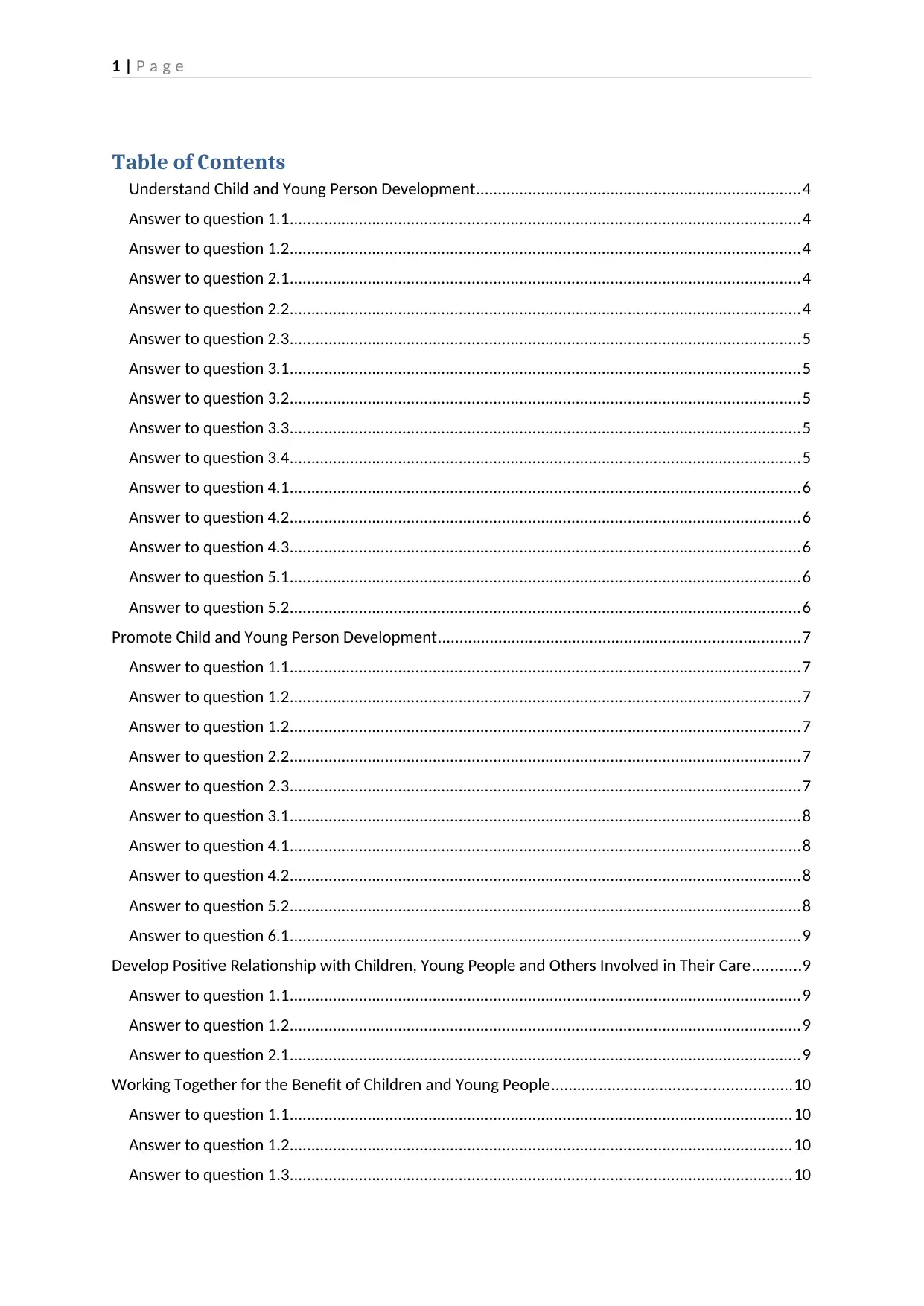
1 | P a g e
Table of Contents
Understand Child and Young Person Development...........................................................................4
Answer to question 1.1......................................................................................................................4
Answer to question 1.2......................................................................................................................4
Answer to question 2.1......................................................................................................................4
Answer to question 2.2......................................................................................................................4
Answer to question 2.3......................................................................................................................5
Answer to question 3.1......................................................................................................................5
Answer to question 3.2......................................................................................................................5
Answer to question 3.3......................................................................................................................5
Answer to question 3.4......................................................................................................................5
Answer to question 4.1......................................................................................................................6
Answer to question 4.2......................................................................................................................6
Answer to question 4.3......................................................................................................................6
Answer to question 5.1......................................................................................................................6
Answer to question 5.2......................................................................................................................6
Promote Child and Young Person Development...................................................................................7
Answer to question 1.1......................................................................................................................7
Answer to question 1.2......................................................................................................................7
Answer to question 1.2......................................................................................................................7
Answer to question 2.2......................................................................................................................7
Answer to question 2.3......................................................................................................................7
Answer to question 3.1......................................................................................................................8
Answer to question 4.1......................................................................................................................8
Answer to question 4.2......................................................................................................................8
Answer to question 5.2......................................................................................................................8
Answer to question 6.1......................................................................................................................9
Develop Positive Relationship with Children, Young People and Others Involved in Their Care...........9
Answer to question 1.1......................................................................................................................9
Answer to question 1.2......................................................................................................................9
Answer to question 2.1......................................................................................................................9
Working Together for the Benefit of Children and Young People.......................................................10
Answer to question 1.1....................................................................................................................10
Answer to question 1.2....................................................................................................................10
Answer to question 1.3....................................................................................................................10
Table of Contents
Understand Child and Young Person Development...........................................................................4
Answer to question 1.1......................................................................................................................4
Answer to question 1.2......................................................................................................................4
Answer to question 2.1......................................................................................................................4
Answer to question 2.2......................................................................................................................4
Answer to question 2.3......................................................................................................................5
Answer to question 3.1......................................................................................................................5
Answer to question 3.2......................................................................................................................5
Answer to question 3.3......................................................................................................................5
Answer to question 3.4......................................................................................................................5
Answer to question 4.1......................................................................................................................6
Answer to question 4.2......................................................................................................................6
Answer to question 4.3......................................................................................................................6
Answer to question 5.1......................................................................................................................6
Answer to question 5.2......................................................................................................................6
Promote Child and Young Person Development...................................................................................7
Answer to question 1.1......................................................................................................................7
Answer to question 1.2......................................................................................................................7
Answer to question 1.2......................................................................................................................7
Answer to question 2.2......................................................................................................................7
Answer to question 2.3......................................................................................................................7
Answer to question 3.1......................................................................................................................8
Answer to question 4.1......................................................................................................................8
Answer to question 4.2......................................................................................................................8
Answer to question 5.2......................................................................................................................8
Answer to question 6.1......................................................................................................................9
Develop Positive Relationship with Children, Young People and Others Involved in Their Care...........9
Answer to question 1.1......................................................................................................................9
Answer to question 1.2......................................................................................................................9
Answer to question 2.1......................................................................................................................9
Working Together for the Benefit of Children and Young People.......................................................10
Answer to question 1.1....................................................................................................................10
Answer to question 1.2....................................................................................................................10
Answer to question 1.3....................................................................................................................10
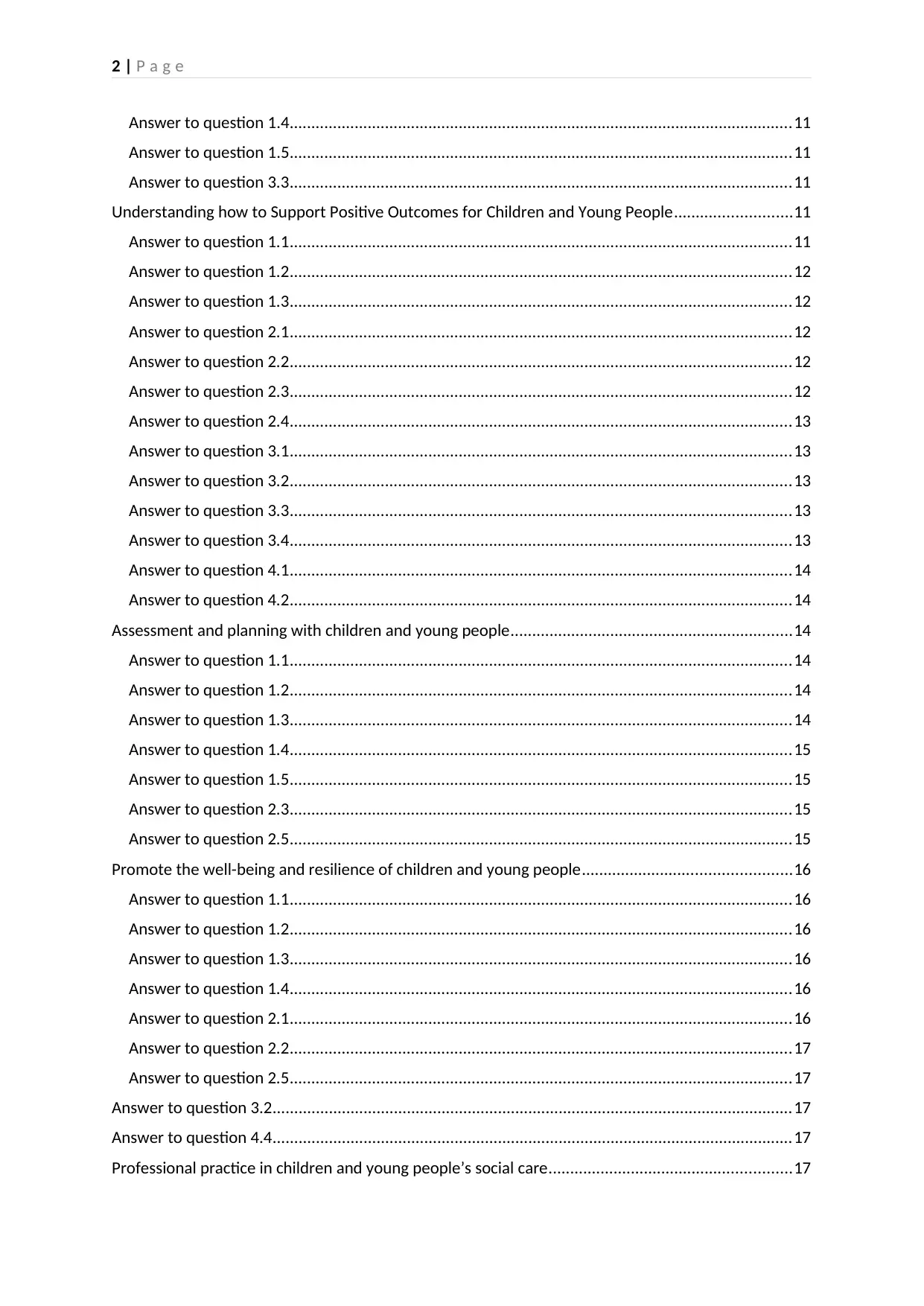
2 | P a g e
Answer to question 1.4....................................................................................................................11
Answer to question 1.5....................................................................................................................11
Answer to question 3.3....................................................................................................................11
Understanding how to Support Positive Outcomes for Children and Young People...........................11
Answer to question 1.1....................................................................................................................11
Answer to question 1.2....................................................................................................................12
Answer to question 1.3....................................................................................................................12
Answer to question 2.1....................................................................................................................12
Answer to question 2.2....................................................................................................................12
Answer to question 2.3....................................................................................................................12
Answer to question 2.4....................................................................................................................13
Answer to question 3.1....................................................................................................................13
Answer to question 3.2....................................................................................................................13
Answer to question 3.3....................................................................................................................13
Answer to question 3.4....................................................................................................................13
Answer to question 4.1....................................................................................................................14
Answer to question 4.2....................................................................................................................14
Assessment and planning with children and young people.................................................................14
Answer to question 1.1....................................................................................................................14
Answer to question 1.2....................................................................................................................14
Answer to question 1.3....................................................................................................................14
Answer to question 1.4....................................................................................................................15
Answer to question 1.5....................................................................................................................15
Answer to question 2.3....................................................................................................................15
Answer to question 2.5....................................................................................................................15
Promote the well-being and resilience of children and young people................................................16
Answer to question 1.1....................................................................................................................16
Answer to question 1.2....................................................................................................................16
Answer to question 1.3....................................................................................................................16
Answer to question 1.4....................................................................................................................16
Answer to question 2.1....................................................................................................................16
Answer to question 2.2....................................................................................................................17
Answer to question 2.5....................................................................................................................17
Answer to question 3.2........................................................................................................................17
Answer to question 4.4........................................................................................................................17
Professional practice in children and young people’s social care........................................................17
Answer to question 1.4....................................................................................................................11
Answer to question 1.5....................................................................................................................11
Answer to question 3.3....................................................................................................................11
Understanding how to Support Positive Outcomes for Children and Young People...........................11
Answer to question 1.1....................................................................................................................11
Answer to question 1.2....................................................................................................................12
Answer to question 1.3....................................................................................................................12
Answer to question 2.1....................................................................................................................12
Answer to question 2.2....................................................................................................................12
Answer to question 2.3....................................................................................................................12
Answer to question 2.4....................................................................................................................13
Answer to question 3.1....................................................................................................................13
Answer to question 3.2....................................................................................................................13
Answer to question 3.3....................................................................................................................13
Answer to question 3.4....................................................................................................................13
Answer to question 4.1....................................................................................................................14
Answer to question 4.2....................................................................................................................14
Assessment and planning with children and young people.................................................................14
Answer to question 1.1....................................................................................................................14
Answer to question 1.2....................................................................................................................14
Answer to question 1.3....................................................................................................................14
Answer to question 1.4....................................................................................................................15
Answer to question 1.5....................................................................................................................15
Answer to question 2.3....................................................................................................................15
Answer to question 2.5....................................................................................................................15
Promote the well-being and resilience of children and young people................................................16
Answer to question 1.1....................................................................................................................16
Answer to question 1.2....................................................................................................................16
Answer to question 1.3....................................................................................................................16
Answer to question 1.4....................................................................................................................16
Answer to question 2.1....................................................................................................................16
Answer to question 2.2....................................................................................................................17
Answer to question 2.5....................................................................................................................17
Answer to question 3.2........................................................................................................................17
Answer to question 4.4........................................................................................................................17
Professional practice in children and young people’s social care........................................................17
⊘ This is a preview!⊘
Do you want full access?
Subscribe today to unlock all pages.

Trusted by 1+ million students worldwide
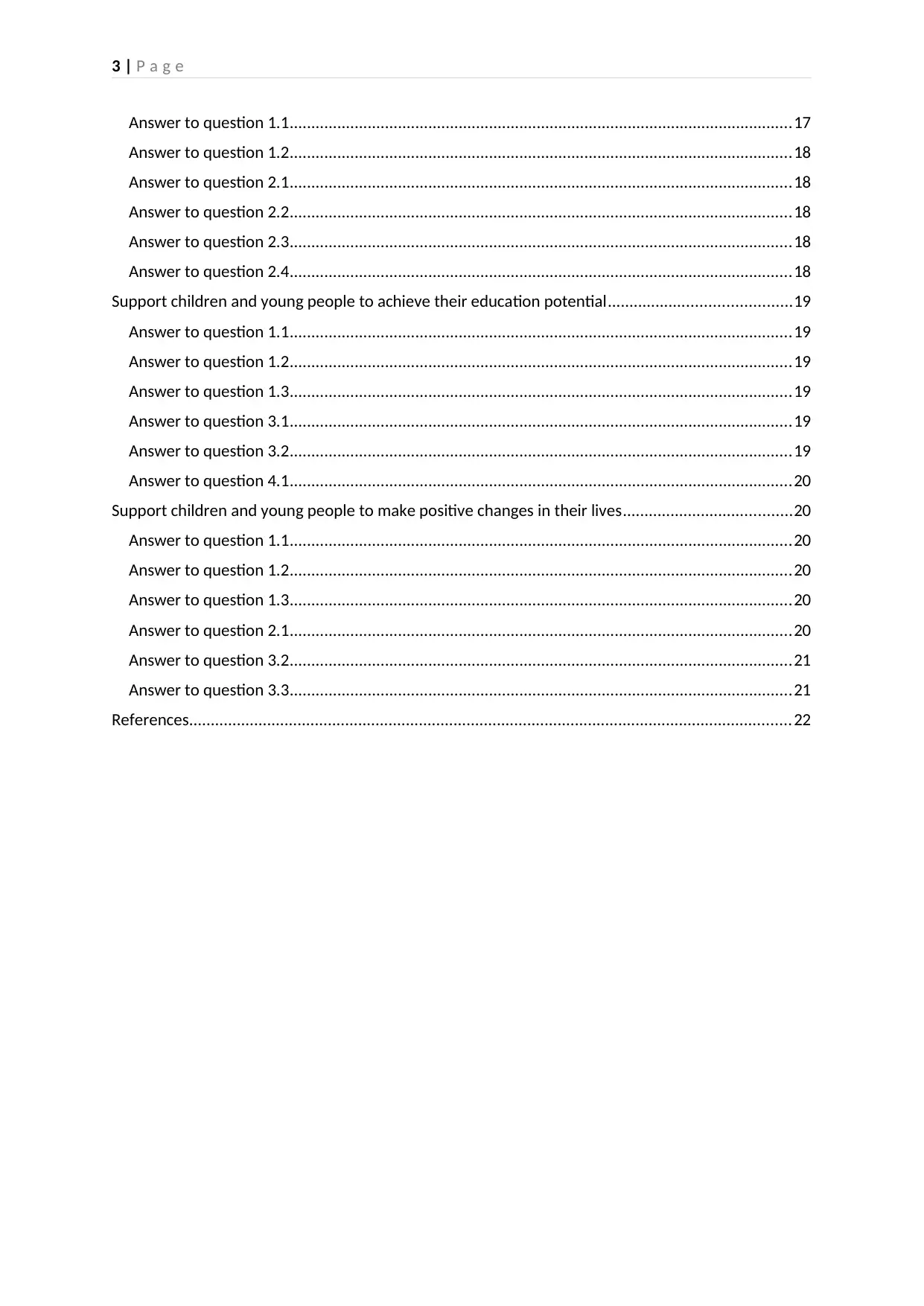
3 | P a g e
Answer to question 1.1....................................................................................................................17
Answer to question 1.2....................................................................................................................18
Answer to question 2.1....................................................................................................................18
Answer to question 2.2....................................................................................................................18
Answer to question 2.3....................................................................................................................18
Answer to question 2.4....................................................................................................................18
Support children and young people to achieve their education potential..........................................19
Answer to question 1.1....................................................................................................................19
Answer to question 1.2....................................................................................................................19
Answer to question 1.3....................................................................................................................19
Answer to question 3.1....................................................................................................................19
Answer to question 3.2....................................................................................................................19
Answer to question 4.1....................................................................................................................20
Support children and young people to make positive changes in their lives.......................................20
Answer to question 1.1....................................................................................................................20
Answer to question 1.2....................................................................................................................20
Answer to question 1.3....................................................................................................................20
Answer to question 2.1....................................................................................................................20
Answer to question 3.2....................................................................................................................21
Answer to question 3.3....................................................................................................................21
References...........................................................................................................................................22
Answer to question 1.1....................................................................................................................17
Answer to question 1.2....................................................................................................................18
Answer to question 2.1....................................................................................................................18
Answer to question 2.2....................................................................................................................18
Answer to question 2.3....................................................................................................................18
Answer to question 2.4....................................................................................................................18
Support children and young people to achieve their education potential..........................................19
Answer to question 1.1....................................................................................................................19
Answer to question 1.2....................................................................................................................19
Answer to question 1.3....................................................................................................................19
Answer to question 3.1....................................................................................................................19
Answer to question 3.2....................................................................................................................19
Answer to question 4.1....................................................................................................................20
Support children and young people to make positive changes in their lives.......................................20
Answer to question 1.1....................................................................................................................20
Answer to question 1.2....................................................................................................................20
Answer to question 1.3....................................................................................................................20
Answer to question 2.1....................................................................................................................20
Answer to question 3.2....................................................................................................................21
Answer to question 3.3....................................................................................................................21
References...........................................................................................................................................22
Paraphrase This Document
Need a fresh take? Get an instant paraphrase of this document with our AI Paraphraser
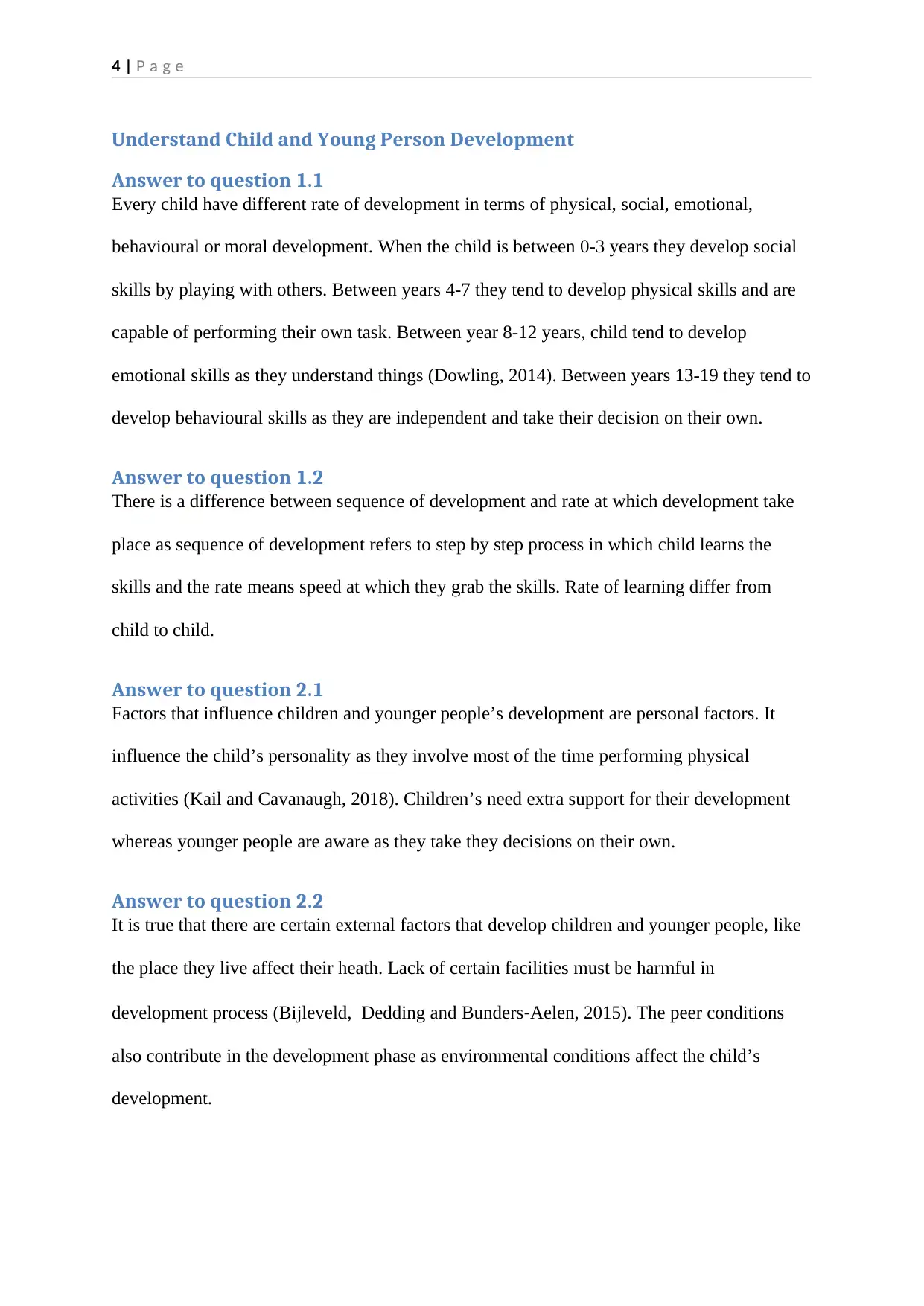
4 | P a g e
Understand Child and Young Person Development
Answer to question 1.1
Every child have different rate of development in terms of physical, social, emotional,
behavioural or moral development. When the child is between 0-3 years they develop social
skills by playing with others. Between years 4-7 they tend to develop physical skills and are
capable of performing their own task. Between year 8-12 years, child tend to develop
emotional skills as they understand things (Dowling, 2014). Between years 13-19 they tend to
develop behavioural skills as they are independent and take their decision on their own.
Answer to question 1.2
There is a difference between sequence of development and rate at which development take
place as sequence of development refers to step by step process in which child learns the
skills and the rate means speed at which they grab the skills. Rate of learning differ from
child to child.
Answer to question 2.1
Factors that influence children and younger people’s development are personal factors. It
influence the child’s personality as they involve most of the time performing physical
activities (Kail and Cavanaugh, 2018). Children’s need extra support for their development
whereas younger people are aware as they take they decisions on their own.
Answer to question 2.2
It is true that there are certain external factors that develop children and younger people, like
the place they live affect their heath. Lack of certain facilities must be harmful in
development process (Bijleveld, Dedding and Bunders‐Aelen, 2015). The peer conditions
also contribute in the development phase as environmental conditions affect the child’s
development.
Understand Child and Young Person Development
Answer to question 1.1
Every child have different rate of development in terms of physical, social, emotional,
behavioural or moral development. When the child is between 0-3 years they develop social
skills by playing with others. Between years 4-7 they tend to develop physical skills and are
capable of performing their own task. Between year 8-12 years, child tend to develop
emotional skills as they understand things (Dowling, 2014). Between years 13-19 they tend to
develop behavioural skills as they are independent and take their decision on their own.
Answer to question 1.2
There is a difference between sequence of development and rate at which development take
place as sequence of development refers to step by step process in which child learns the
skills and the rate means speed at which they grab the skills. Rate of learning differ from
child to child.
Answer to question 2.1
Factors that influence children and younger people’s development are personal factors. It
influence the child’s personality as they involve most of the time performing physical
activities (Kail and Cavanaugh, 2018). Children’s need extra support for their development
whereas younger people are aware as they take they decisions on their own.
Answer to question 2.2
It is true that there are certain external factors that develop children and younger people, like
the place they live affect their heath. Lack of certain facilities must be harmful in
development process (Bijleveld, Dedding and Bunders‐Aelen, 2015). The peer conditions
also contribute in the development phase as environmental conditions affect the child’s
development.
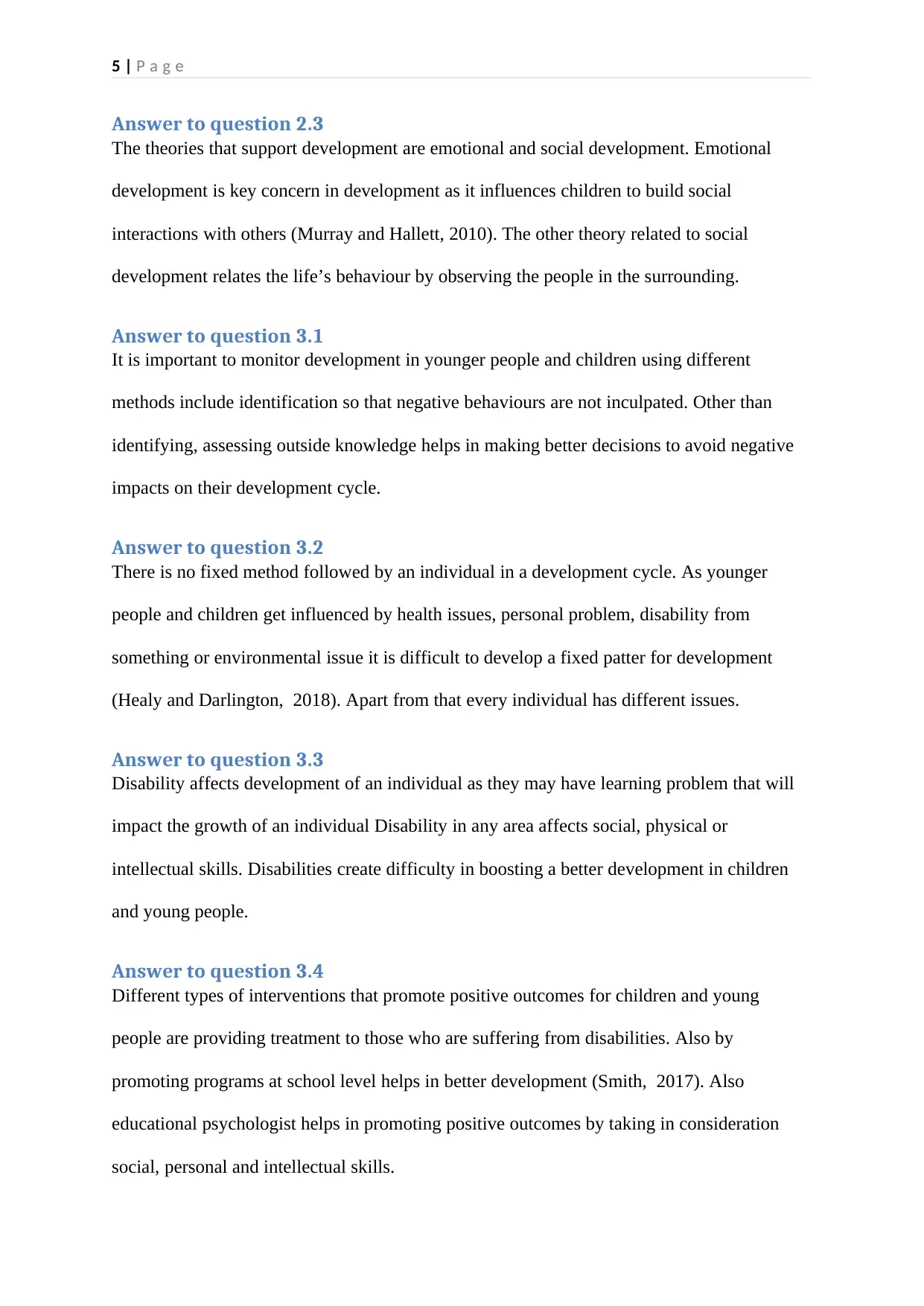
5 | P a g e
Answer to question 2.3
The theories that support development are emotional and social development. Emotional
development is key concern in development as it influences children to build social
interactions with others (Murray and Hallett, 2010). The other theory related to social
development relates the life’s behaviour by observing the people in the surrounding.
Answer to question 3.1
It is important to monitor development in younger people and children using different
methods include identification so that negative behaviours are not inculpated. Other than
identifying, assessing outside knowledge helps in making better decisions to avoid negative
impacts on their development cycle.
Answer to question 3.2
There is no fixed method followed by an individual in a development cycle. As younger
people and children get influenced by health issues, personal problem, disability from
something or environmental issue it is difficult to develop a fixed patter for development
(Healy and Darlington, 2018). Apart from that every individual has different issues.
Answer to question 3.3
Disability affects development of an individual as they may have learning problem that will
impact the growth of an individual Disability in any area affects social, physical or
intellectual skills. Disabilities create difficulty in boosting a better development in children
and young people.
Answer to question 3.4
Different types of interventions that promote positive outcomes for children and young
people are providing treatment to those who are suffering from disabilities. Also by
promoting programs at school level helps in better development (Smith, 2017). Also
educational psychologist helps in promoting positive outcomes by taking in consideration
social, personal and intellectual skills.
Answer to question 2.3
The theories that support development are emotional and social development. Emotional
development is key concern in development as it influences children to build social
interactions with others (Murray and Hallett, 2010). The other theory related to social
development relates the life’s behaviour by observing the people in the surrounding.
Answer to question 3.1
It is important to monitor development in younger people and children using different
methods include identification so that negative behaviours are not inculpated. Other than
identifying, assessing outside knowledge helps in making better decisions to avoid negative
impacts on their development cycle.
Answer to question 3.2
There is no fixed method followed by an individual in a development cycle. As younger
people and children get influenced by health issues, personal problem, disability from
something or environmental issue it is difficult to develop a fixed patter for development
(Healy and Darlington, 2018). Apart from that every individual has different issues.
Answer to question 3.3
Disability affects development of an individual as they may have learning problem that will
impact the growth of an individual Disability in any area affects social, physical or
intellectual skills. Disabilities create difficulty in boosting a better development in children
and young people.
Answer to question 3.4
Different types of interventions that promote positive outcomes for children and young
people are providing treatment to those who are suffering from disabilities. Also by
promoting programs at school level helps in better development (Smith, 2017). Also
educational psychologist helps in promoting positive outcomes by taking in consideration
social, personal and intellectual skills.
⊘ This is a preview!⊘
Do you want full access?
Subscribe today to unlock all pages.

Trusted by 1+ million students worldwide
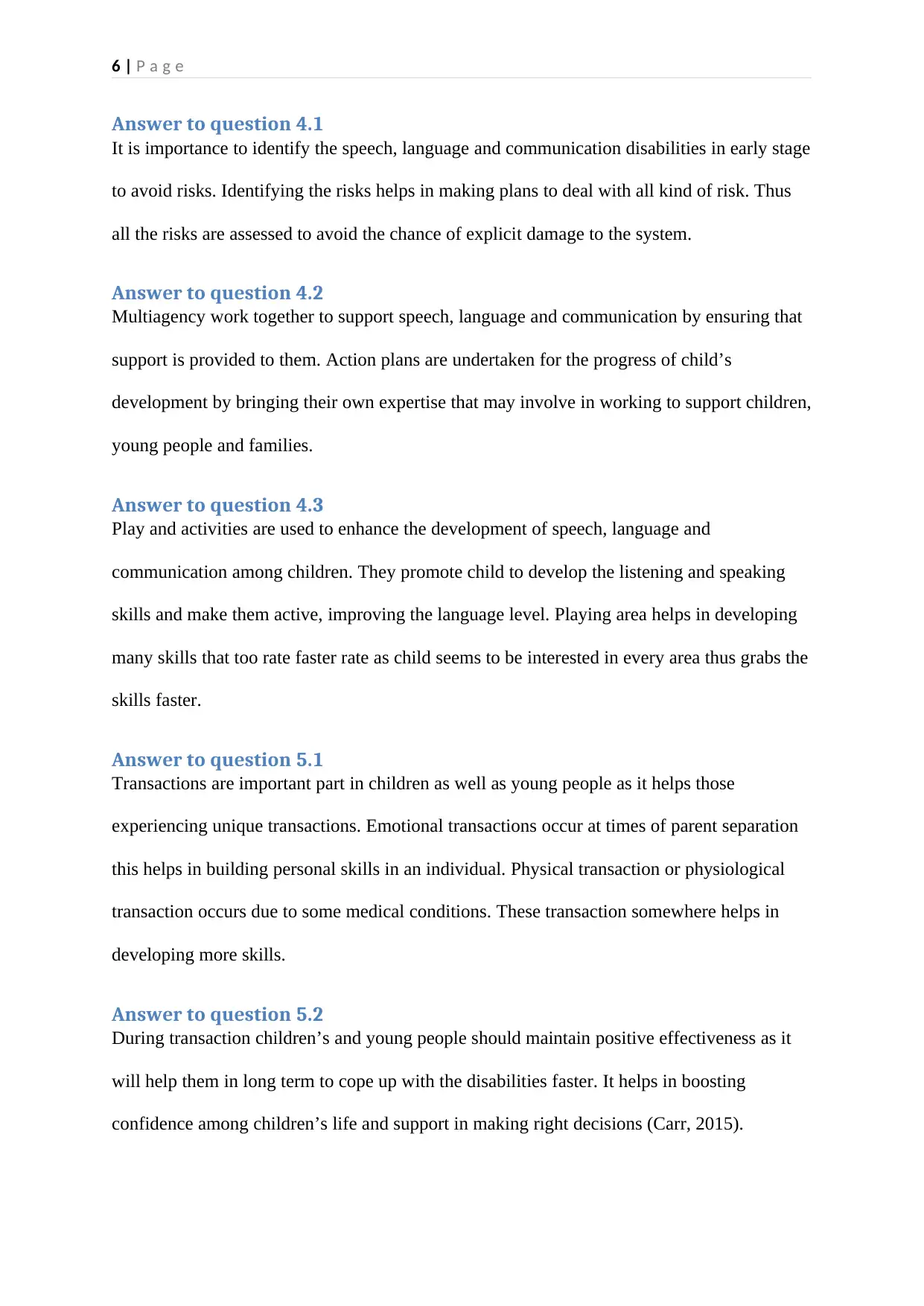
6 | P a g e
Answer to question 4.1
It is importance to identify the speech, language and communication disabilities in early stage
to avoid risks. Identifying the risks helps in making plans to deal with all kind of risk. Thus
all the risks are assessed to avoid the chance of explicit damage to the system.
Answer to question 4.2
Multiagency work together to support speech, language and communication by ensuring that
support is provided to them. Action plans are undertaken for the progress of child’s
development by bringing their own expertise that may involve in working to support children,
young people and families.
Answer to question 4.3
Play and activities are used to enhance the development of speech, language and
communication among children. They promote child to develop the listening and speaking
skills and make them active, improving the language level. Playing area helps in developing
many skills that too rate faster rate as child seems to be interested in every area thus grabs the
skills faster.
Answer to question 5.1
Transactions are important part in children as well as young people as it helps those
experiencing unique transactions. Emotional transactions occur at times of parent separation
this helps in building personal skills in an individual. Physical transaction or physiological
transaction occurs due to some medical conditions. These transaction somewhere helps in
developing more skills.
Answer to question 5.2
During transaction children’s and young people should maintain positive effectiveness as it
will help them in long term to cope up with the disabilities faster. It helps in boosting
confidence among children’s life and support in making right decisions (Carr, 2015).
Answer to question 4.1
It is importance to identify the speech, language and communication disabilities in early stage
to avoid risks. Identifying the risks helps in making plans to deal with all kind of risk. Thus
all the risks are assessed to avoid the chance of explicit damage to the system.
Answer to question 4.2
Multiagency work together to support speech, language and communication by ensuring that
support is provided to them. Action plans are undertaken for the progress of child’s
development by bringing their own expertise that may involve in working to support children,
young people and families.
Answer to question 4.3
Play and activities are used to enhance the development of speech, language and
communication among children. They promote child to develop the listening and speaking
skills and make them active, improving the language level. Playing area helps in developing
many skills that too rate faster rate as child seems to be interested in every area thus grabs the
skills faster.
Answer to question 5.1
Transactions are important part in children as well as young people as it helps those
experiencing unique transactions. Emotional transactions occur at times of parent separation
this helps in building personal skills in an individual. Physical transaction or physiological
transaction occurs due to some medical conditions. These transaction somewhere helps in
developing more skills.
Answer to question 5.2
During transaction children’s and young people should maintain positive effectiveness as it
will help them in long term to cope up with the disabilities faster. It helps in boosting
confidence among children’s life and support in making right decisions (Carr, 2015).
Paraphrase This Document
Need a fresh take? Get an instant paraphrase of this document with our AI Paraphraser
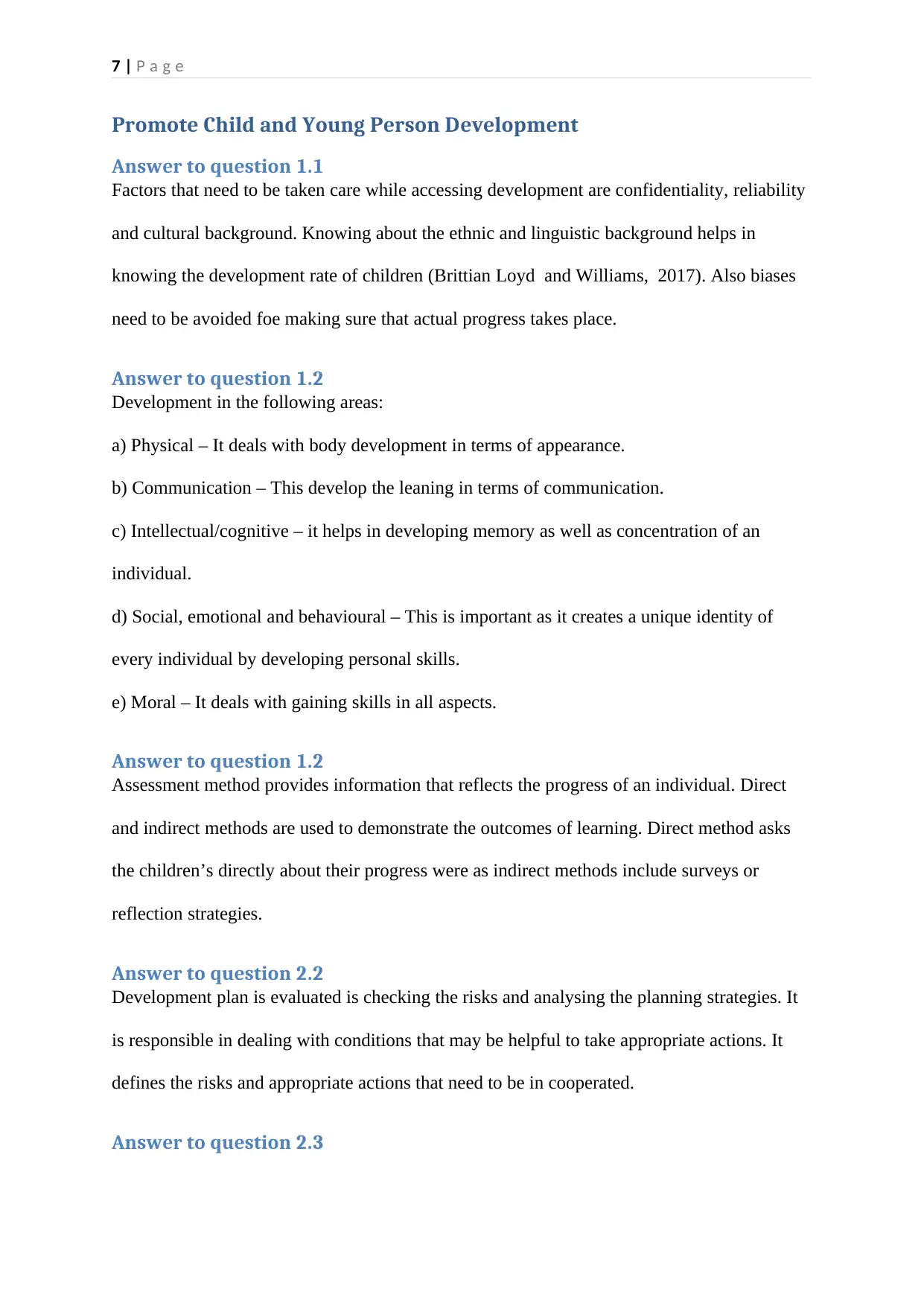
7 | P a g e
Promote Child and Young Person Development
Answer to question 1.1
Factors that need to be taken care while accessing development are confidentiality, reliability
and cultural background. Knowing about the ethnic and linguistic background helps in
knowing the development rate of children (Brittian Loyd and Williams, 2017). Also biases
need to be avoided foe making sure that actual progress takes place.
Answer to question 1.2
Development in the following areas:
a) Physical – It deals with body development in terms of appearance.
b) Communication – This develop the leaning in terms of communication.
c) Intellectual/cognitive – it helps in developing memory as well as concentration of an
individual.
d) Social, emotional and behavioural – This is important as it creates a unique identity of
every individual by developing personal skills.
e) Moral – It deals with gaining skills in all aspects.
Answer to question 1.2
Assessment method provides information that reflects the progress of an individual. Direct
and indirect methods are used to demonstrate the outcomes of learning. Direct method asks
the children’s directly about their progress were as indirect methods include surveys or
reflection strategies.
Answer to question 2.2
Development plan is evaluated is checking the risks and analysing the planning strategies. It
is responsible in dealing with conditions that may be helpful to take appropriate actions. It
defines the risks and appropriate actions that need to be in cooperated.
Answer to question 2.3
Promote Child and Young Person Development
Answer to question 1.1
Factors that need to be taken care while accessing development are confidentiality, reliability
and cultural background. Knowing about the ethnic and linguistic background helps in
knowing the development rate of children (Brittian Loyd and Williams, 2017). Also biases
need to be avoided foe making sure that actual progress takes place.
Answer to question 1.2
Development in the following areas:
a) Physical – It deals with body development in terms of appearance.
b) Communication – This develop the leaning in terms of communication.
c) Intellectual/cognitive – it helps in developing memory as well as concentration of an
individual.
d) Social, emotional and behavioural – This is important as it creates a unique identity of
every individual by developing personal skills.
e) Moral – It deals with gaining skills in all aspects.
Answer to question 1.2
Assessment method provides information that reflects the progress of an individual. Direct
and indirect methods are used to demonstrate the outcomes of learning. Direct method asks
the children’s directly about their progress were as indirect methods include surveys or
reflection strategies.
Answer to question 2.2
Development plan is evaluated is checking the risks and analysing the planning strategies. It
is responsible in dealing with conditions that may be helpful to take appropriate actions. It
defines the risks and appropriate actions that need to be in cooperated.
Answer to question 2.3
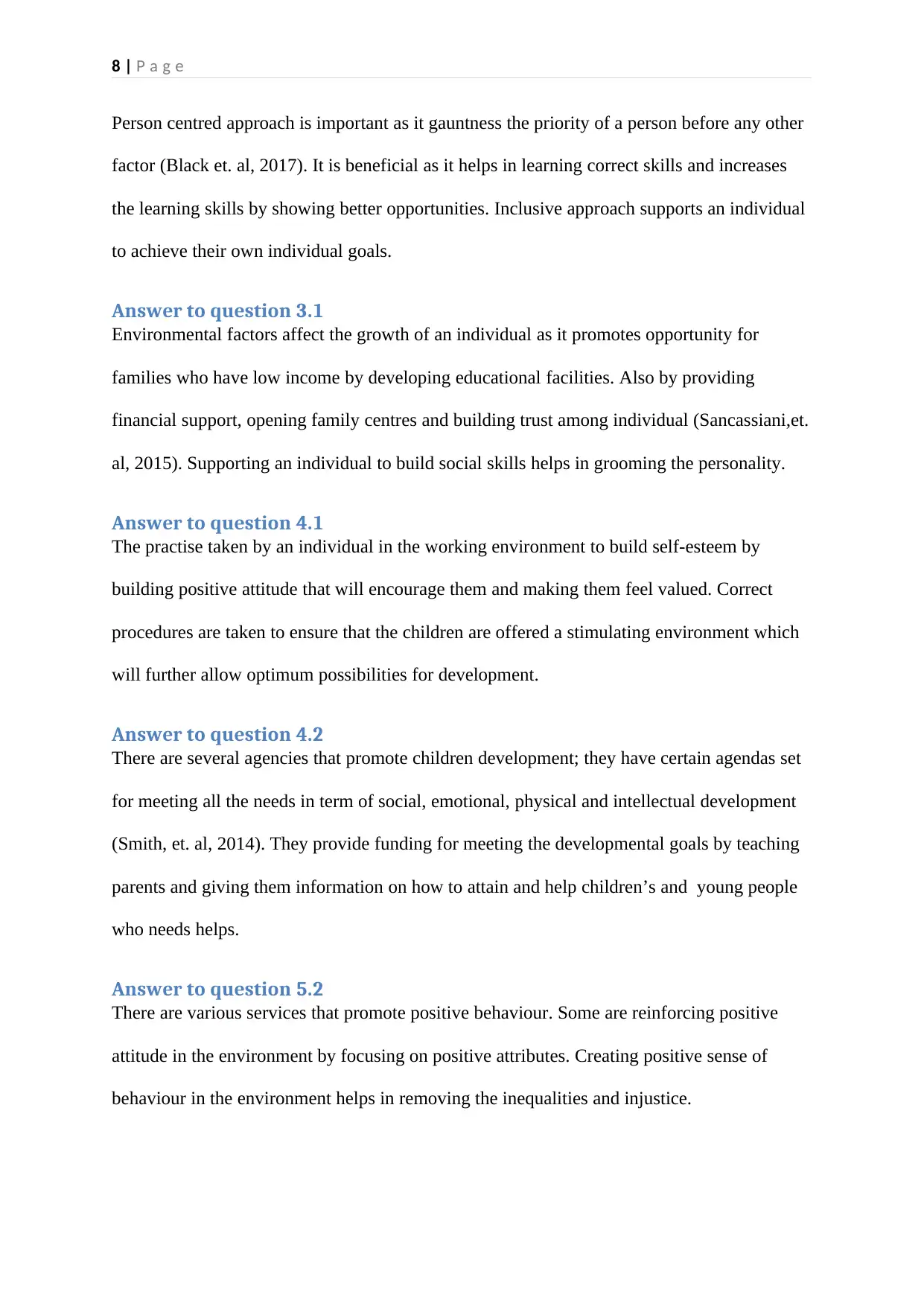
8 | P a g e
Person centred approach is important as it gauntness the priority of a person before any other
factor (Black et. al, 2017). It is beneficial as it helps in learning correct skills and increases
the learning skills by showing better opportunities. Inclusive approach supports an individual
to achieve their own individual goals.
Answer to question 3.1
Environmental factors affect the growth of an individual as it promotes opportunity for
families who have low income by developing educational facilities. Also by providing
financial support, opening family centres and building trust among individual (Sancassiani,et.
al, 2015). Supporting an individual to build social skills helps in grooming the personality.
Answer to question 4.1
The practise taken by an individual in the working environment to build self-esteem by
building positive attitude that will encourage them and making them feel valued. Correct
procedures are taken to ensure that the children are offered a stimulating environment which
will further allow optimum possibilities for development.
Answer to question 4.2
There are several agencies that promote children development; they have certain agendas set
for meeting all the needs in term of social, emotional, physical and intellectual development
(Smith, et. al, 2014). They provide funding for meeting the developmental goals by teaching
parents and giving them information on how to attain and help children’s and young people
who needs helps.
Answer to question 5.2
There are various services that promote positive behaviour. Some are reinforcing positive
attitude in the environment by focusing on positive attributes. Creating positive sense of
behaviour in the environment helps in removing the inequalities and injustice.
Person centred approach is important as it gauntness the priority of a person before any other
factor (Black et. al, 2017). It is beneficial as it helps in learning correct skills and increases
the learning skills by showing better opportunities. Inclusive approach supports an individual
to achieve their own individual goals.
Answer to question 3.1
Environmental factors affect the growth of an individual as it promotes opportunity for
families who have low income by developing educational facilities. Also by providing
financial support, opening family centres and building trust among individual (Sancassiani,et.
al, 2015). Supporting an individual to build social skills helps in grooming the personality.
Answer to question 4.1
The practise taken by an individual in the working environment to build self-esteem by
building positive attitude that will encourage them and making them feel valued. Correct
procedures are taken to ensure that the children are offered a stimulating environment which
will further allow optimum possibilities for development.
Answer to question 4.2
There are several agencies that promote children development; they have certain agendas set
for meeting all the needs in term of social, emotional, physical and intellectual development
(Smith, et. al, 2014). They provide funding for meeting the developmental goals by teaching
parents and giving them information on how to attain and help children’s and young people
who needs helps.
Answer to question 5.2
There are various services that promote positive behaviour. Some are reinforcing positive
attitude in the environment by focusing on positive attributes. Creating positive sense of
behaviour in the environment helps in removing the inequalities and injustice.
⊘ This is a preview!⊘
Do you want full access?
Subscribe today to unlock all pages.

Trusted by 1+ million students worldwide
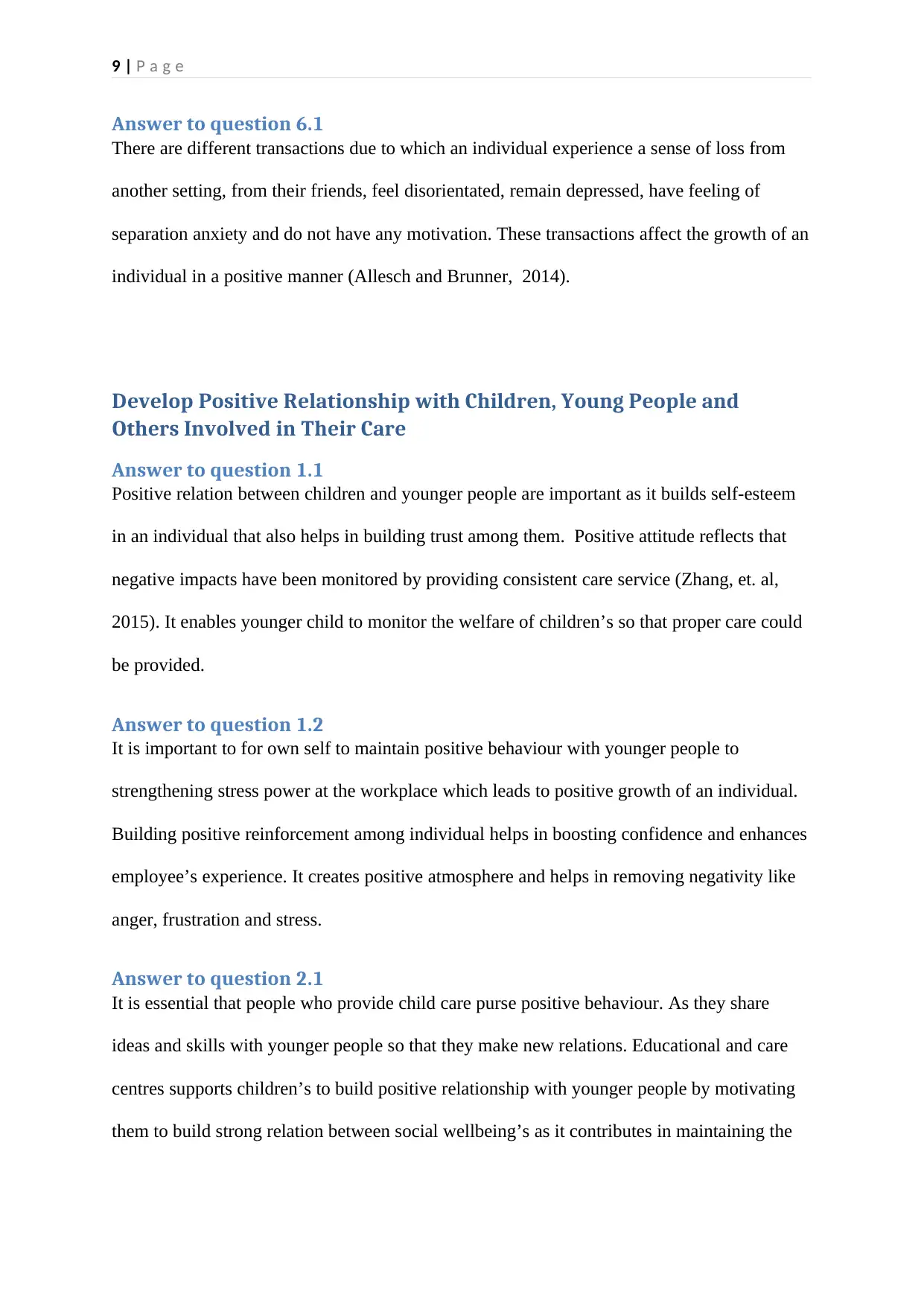
9 | P a g e
Answer to question 6.1
There are different transactions due to which an individual experience a sense of loss from
another setting, from their friends, feel disorientated, remain depressed, have feeling of
separation anxiety and do not have any motivation. These transactions affect the growth of an
individual in a positive manner (Allesch and Brunner, 2014).
Develop Positive Relationship with Children, Young People and
Others Involved in Their Care
Answer to question 1.1
Positive relation between children and younger people are important as it builds self-esteem
in an individual that also helps in building trust among them. Positive attitude reflects that
negative impacts have been monitored by providing consistent care service (Zhang, et. al,
2015). It enables younger child to monitor the welfare of children’s so that proper care could
be provided.
Answer to question 1.2
It is important to for own self to maintain positive behaviour with younger people to
strengthening stress power at the workplace which leads to positive growth of an individual.
Building positive reinforcement among individual helps in boosting confidence and enhances
employee’s experience. It creates positive atmosphere and helps in removing negativity like
anger, frustration and stress.
Answer to question 2.1
It is essential that people who provide child care purse positive behaviour. As they share
ideas and skills with younger people so that they make new relations. Educational and care
centres supports children’s to build positive relationship with younger people by motivating
them to build strong relation between social wellbeing’s as it contributes in maintaining the
Answer to question 6.1
There are different transactions due to which an individual experience a sense of loss from
another setting, from their friends, feel disorientated, remain depressed, have feeling of
separation anxiety and do not have any motivation. These transactions affect the growth of an
individual in a positive manner (Allesch and Brunner, 2014).
Develop Positive Relationship with Children, Young People and
Others Involved in Their Care
Answer to question 1.1
Positive relation between children and younger people are important as it builds self-esteem
in an individual that also helps in building trust among them. Positive attitude reflects that
negative impacts have been monitored by providing consistent care service (Zhang, et. al,
2015). It enables younger child to monitor the welfare of children’s so that proper care could
be provided.
Answer to question 1.2
It is important to for own self to maintain positive behaviour with younger people to
strengthening stress power at the workplace which leads to positive growth of an individual.
Building positive reinforcement among individual helps in boosting confidence and enhances
employee’s experience. It creates positive atmosphere and helps in removing negativity like
anger, frustration and stress.
Answer to question 2.1
It is essential that people who provide child care purse positive behaviour. As they share
ideas and skills with younger people so that they make new relations. Educational and care
centres supports children’s to build positive relationship with younger people by motivating
them to build strong relation between social wellbeing’s as it contributes in maintaining the
Paraphrase This Document
Need a fresh take? Get an instant paraphrase of this document with our AI Paraphraser
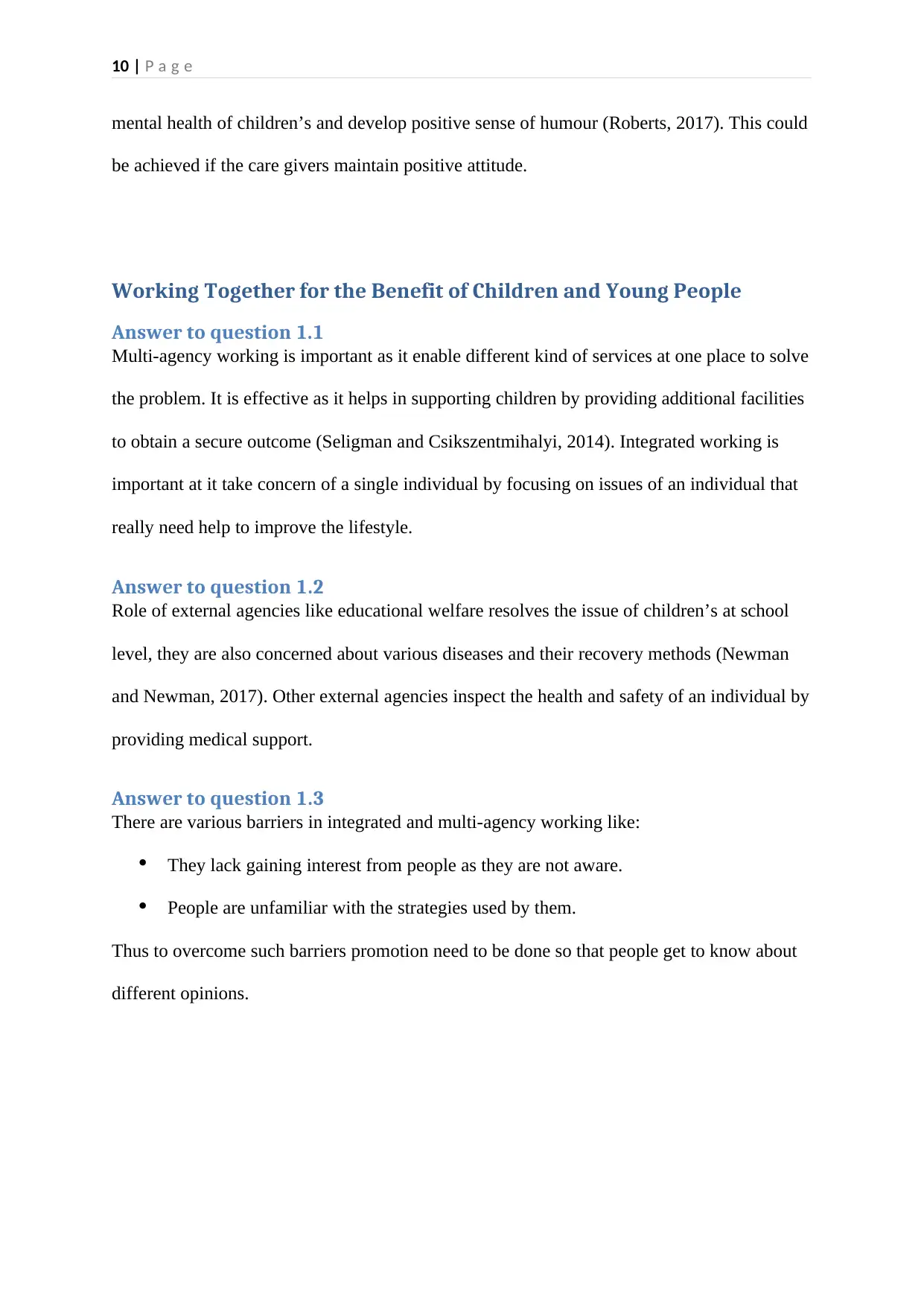
10 | P a g e
mental health of children’s and develop positive sense of humour (Roberts, 2017). This could
be achieved if the care givers maintain positive attitude.
Working Together for the Benefit of Children and Young People
Answer to question 1.1
Multi-agency working is important as it enable different kind of services at one place to solve
the problem. It is effective as it helps in supporting children by providing additional facilities
to obtain a secure outcome (Seligman and Csikszentmihalyi, 2014). Integrated working is
important at it take concern of a single individual by focusing on issues of an individual that
really need help to improve the lifestyle.
Answer to question 1.2
Role of external agencies like educational welfare resolves the issue of children’s at school
level, they are also concerned about various diseases and their recovery methods (Newman
and Newman, 2017). Other external agencies inspect the health and safety of an individual by
providing medical support.
Answer to question 1.3
There are various barriers in integrated and multi-agency working like:
They lack gaining interest from people as they are not aware.
People are unfamiliar with the strategies used by them.
Thus to overcome such barriers promotion need to be done so that people get to know about
different opinions.
mental health of children’s and develop positive sense of humour (Roberts, 2017). This could
be achieved if the care givers maintain positive attitude.
Working Together for the Benefit of Children and Young People
Answer to question 1.1
Multi-agency working is important as it enable different kind of services at one place to solve
the problem. It is effective as it helps in supporting children by providing additional facilities
to obtain a secure outcome (Seligman and Csikszentmihalyi, 2014). Integrated working is
important at it take concern of a single individual by focusing on issues of an individual that
really need help to improve the lifestyle.
Answer to question 1.2
Role of external agencies like educational welfare resolves the issue of children’s at school
level, they are also concerned about various diseases and their recovery methods (Newman
and Newman, 2017). Other external agencies inspect the health and safety of an individual by
providing medical support.
Answer to question 1.3
There are various barriers in integrated and multi-agency working like:
They lack gaining interest from people as they are not aware.
People are unfamiliar with the strategies used by them.
Thus to overcome such barriers promotion need to be done so that people get to know about
different opinions.
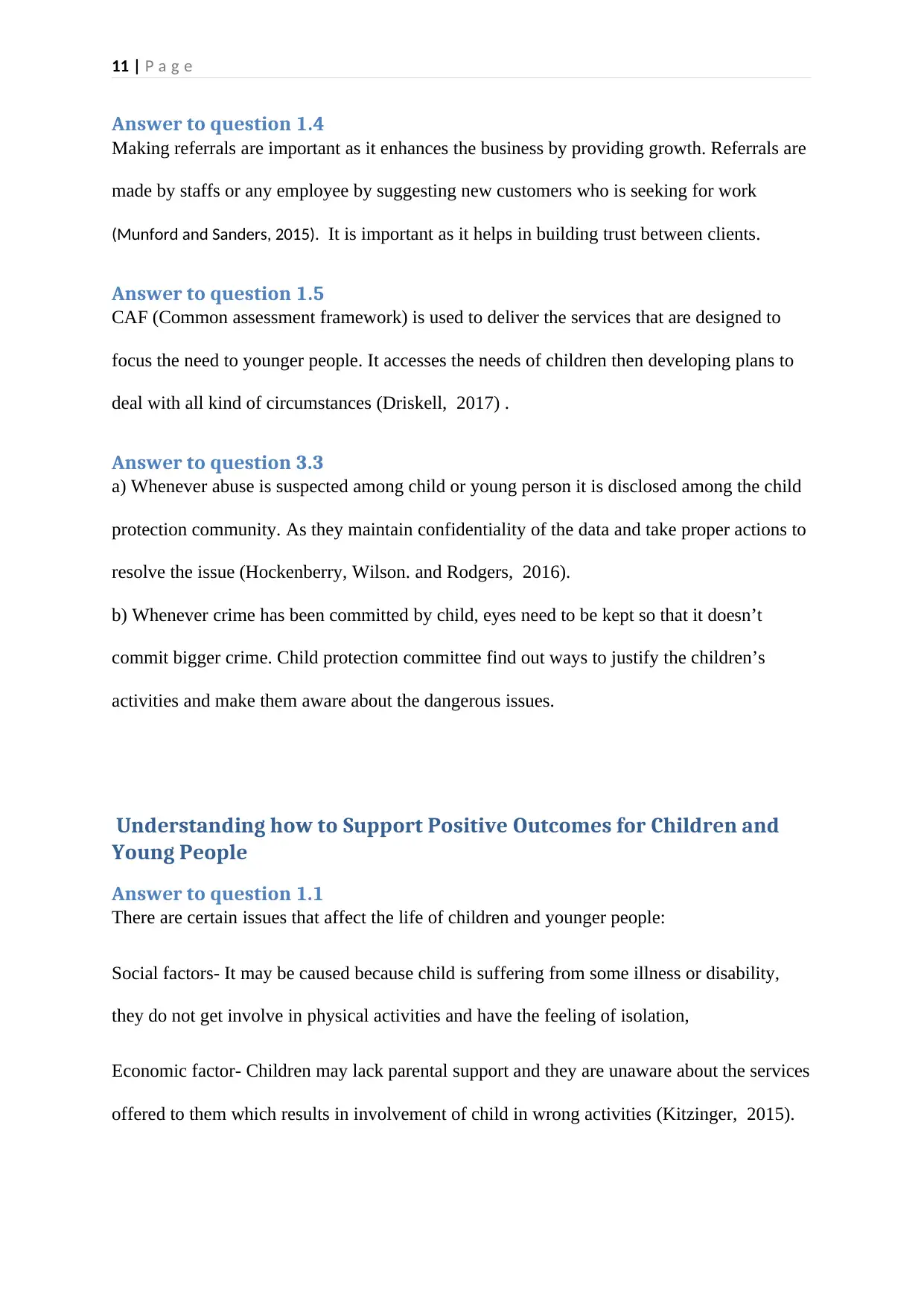
11 | P a g e
Answer to question 1.4
Making referrals are important as it enhances the business by providing growth. Referrals are
made by staffs or any employee by suggesting new customers who is seeking for work
(Munford and Sanders, 2015). It is important as it helps in building trust between clients.
Answer to question 1.5
CAF (Common assessment framework) is used to deliver the services that are designed to
focus the need to younger people. It accesses the needs of children then developing plans to
deal with all kind of circumstances (Driskell, 2017) .
Answer to question 3.3
a) Whenever abuse is suspected among child or young person it is disclosed among the child
protection community. As they maintain confidentiality of the data and take proper actions to
resolve the issue (Hockenberry, Wilson. and Rodgers, 2016).
b) Whenever crime has been committed by child, eyes need to be kept so that it doesn’t
commit bigger crime. Child protection committee find out ways to justify the children’s
activities and make them aware about the dangerous issues.
Understanding how to Support Positive Outcomes for Children and
Young People
Answer to question 1.1
There are certain issues that affect the life of children and younger people:
Social factors- It may be caused because child is suffering from some illness or disability,
they do not get involve in physical activities and have the feeling of isolation,
Economic factor- Children may lack parental support and they are unaware about the services
offered to them which results in involvement of child in wrong activities (Kitzinger, 2015).
Answer to question 1.4
Making referrals are important as it enhances the business by providing growth. Referrals are
made by staffs or any employee by suggesting new customers who is seeking for work
(Munford and Sanders, 2015). It is important as it helps in building trust between clients.
Answer to question 1.5
CAF (Common assessment framework) is used to deliver the services that are designed to
focus the need to younger people. It accesses the needs of children then developing plans to
deal with all kind of circumstances (Driskell, 2017) .
Answer to question 3.3
a) Whenever abuse is suspected among child or young person it is disclosed among the child
protection community. As they maintain confidentiality of the data and take proper actions to
resolve the issue (Hockenberry, Wilson. and Rodgers, 2016).
b) Whenever crime has been committed by child, eyes need to be kept so that it doesn’t
commit bigger crime. Child protection committee find out ways to justify the children’s
activities and make them aware about the dangerous issues.
Understanding how to Support Positive Outcomes for Children and
Young People
Answer to question 1.1
There are certain issues that affect the life of children and younger people:
Social factors- It may be caused because child is suffering from some illness or disability,
they do not get involve in physical activities and have the feeling of isolation,
Economic factor- Children may lack parental support and they are unaware about the services
offered to them which results in involvement of child in wrong activities (Kitzinger, 2015).
⊘ This is a preview!⊘
Do you want full access?
Subscribe today to unlock all pages.

Trusted by 1+ million students worldwide
1 out of 28
Related Documents
Your All-in-One AI-Powered Toolkit for Academic Success.
+13062052269
info@desklib.com
Available 24*7 on WhatsApp / Email
![[object Object]](/_next/static/media/star-bottom.7253800d.svg)
Unlock your academic potential
Copyright © 2020–2025 A2Z Services. All Rights Reserved. Developed and managed by ZUCOL.





